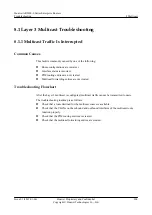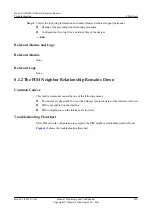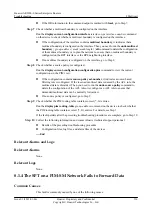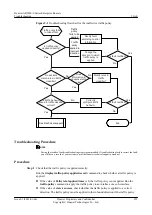
l
If the number of received Join/Prune messages on the downstream interface does not
increase, run the
display pim control-message counters
interface
interface-type
interface-number
message-type join-prune
command on the downstream device to check
whether it has sent Join/Prune messages upstream.
–
If the command output shows that the number of sent Join/Prune messages keeps
increasing, it indicates that the downstream device has sent Join/Prune messages. The
fault may be caused by a failure in PIM neighbor communication. In such a case, go to
Step 9.
–
If the command output shows that the number of sent Join/Prune messages does not
increase, it indicates the downstream device experiences a fault. Then locate the fault.
l
If the number of received Join/Prune messages on the downstream interface keeps
increasing, go to Step 3.
Step 3
Check that PIM-SM is enabled on interfaces.
The following interfaces are easy to be ignored in enabling PIM-SM:
l
RPF neighboring interface to the multicast source
l
RPF interface to the multicast source
NOTE
In PIM-SM network deployment, you are recommended to enable the multicast function on all the devices
on the network and enable PIM-SM on all the interfaces.
Run the
display pim interface
verbose
command to check PIM configurations on the interface.
Focus on checking whether PIM-SM is enabled on the preceding interfaces.
l
If the command output does not contain information about an interface of the device or the
PIM mode of an interface is dense, you need to run the
pim sm
command on the interface.
If the system prompts that "Warning: Please enable multicast routing first" when you
configure PIM-SM on the interface, run the
multicast routing-enable
command in the
system view to enable the multicast function first and run the
pim sm
command in the
interface view to enable PIM-SM on the interface.
l
If PIM-SM has been enabled on all the interfaces on the device, go to Step 4.
Step 4
Check that an RPF route to the multicast source is available.
Run the
display multicast rpf-info
source-address
command on the device to check whether
there is an RPF route to the multicast source.
l
If the command output does not contain any RPF route to the RP, check the configurations
of unicast routes. Run the
ping
command on the device and the RP to check whether they
can ping each other successfully.
l
If the command output contains an RPF route to the multicast source, do as follows:
–
If the command output shows that the RPF route is a static multicast route, run the
display current-configuration
command to check whether the static multicast route
is properly configured.
–
If the command output shows that the RPF route is a unicast route, run the
display ip
routing-table
command to check whether the unicast route is consistent with the RPF
route.
l
If the command output contains an RPF route to the RP and the route is properly configured,
go to Step 5.
Step 5
Check that the interface that forwards multicast data is the receiver's DR.
Huawei AR2200-S Series Enterprise Routers
Troubleshooting
8 Multicast
Issue 01 (2012-01-06)
Huawei Proprietary and Confidential
Copyright © Huawei Technologies Co., Ltd.
220






























